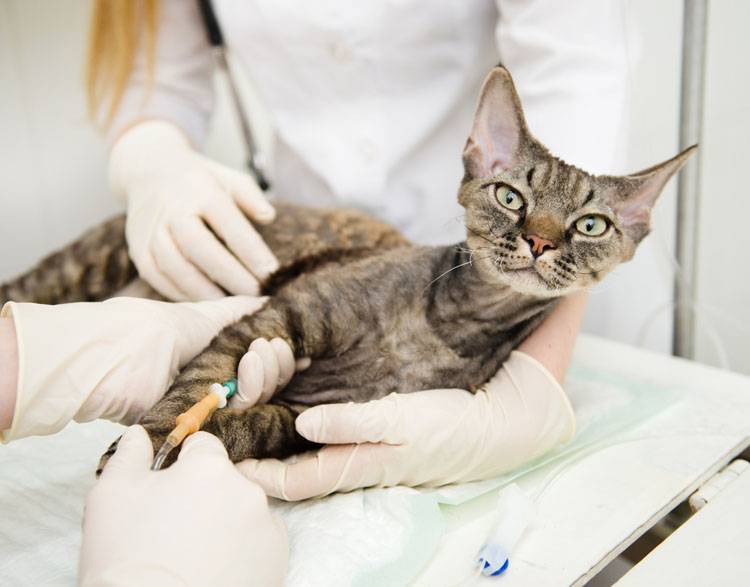Managing Chronic Kidney Disease in Cats
By Karen Doane, RVT
Chronic Renal Failure (or CRF) is a long-term, gradual loss of kidney (renal) function. It is a common medical condition in adult and senior cats. Younger cats can also develop CRF. On the outside, it might appear as though your cat’s kidneys have suddenly quit working, but in fact the damage within each kidney has been happening for quite some time.
How do kidneys work?
The functional unit within the kidney is called a nephron. Each nephron is a tiny filter that removes certain waste products from the blood and controls the amount of water and electrolytes held within or eliminated from the body. There are hundreds of thousands of nephrons in each of the cat’s two kidneys. The kidney also keeps blood pressure at the proper level and helps red blood cell production as well.
In some cats, nephrons cease to function and die off as the cat ages. You might think this gradual loss is apparent. However, the amazing kidney continues to work until up to 70 percent of its nephrons have died. Unfortunately, once a nephron has died, nothing can be done to restore it.
What does chronic renal failure look like?
The first signs of chronic renal failure are usually increased urination and water intake. Your cat might visit the litterbox more often and leave larger clumps of urine. Some cats will urinate outside of the litterbox as well. You might also see your cat drinking more frequently and/or drinking for longer periods of time.
Chronic renal failure can cause:
- Nausea and vomiting
- Lack of appetite
- Lower energy levels
- Muscle loss
- Unkempt appearance
- Electrolyte deficiencies
In the early stages of the disease, there are usually no signs or symptoms at all. To diagnose this condition early, your veterinarian can do simple blood and urine tests on your cat to find out how well the kidneys are functioning. These tests can—and should—be done at least once a year as part of your cat’s wellness routine. The sooner a renal function issue is detected, the more treatment options are available to extend both the quantity and the quality of your cat’s life.
RELATED: Is Pre-Surgical Blood Work Really Necessary?
How do you treat chronic renal failure?
Feed a Special Diet and Encourage Water Drinking
The bad news is there is no cure for renal failure in cats. The good news is there are many ways to manage CRF. Advances in veterinary medicine continue as do treatment options. If renal function loss is detected before your cat begins to show outward signs, a special diet along with encouraging the cat to drink more water may be the only treatments necessary for the first few months—or years. Your veterinarian will schedule regular blood and urine tests (usually once or twice a year) to monitor the cat’s kidney function.
If the disease has reached the point where outward signs are present and renal function has greatly diminished, there is still a chance the cat will respond well to treatment. Poor renal function inevitably leads to dehydration. The veterinarian will hydrate your cat and flush out built-up waste products by administering intravenous fluids. Your cat will have to stay at the veterinary hospital for a few days during this important first stage of the treatment process.
Afterwards, the staff will provide instructions on how to care for your cat at home. Your cat must now go on a diet especially formulated for cats with renal failure. You may also have to bring your cat to the veterinary hospital regularly for administration of fluids under the skin (subcutaneous fluids), or you could opt to do this at home. There are supportive medications that can also be helpful in maintaining the length and quality of your cat’s life.
Consider Kidney Dialysis
If money is no object, a few specialty veterinary hospitals now offer kidney dialysis for cats. There are even kidney transplants available for cats. I heard that gasp! No, veterinarians do not euthanize one cat to provide kidneys for another. The owner of the kidney-recipient cat must agree to adopt and care for the kidney-donor cat, so both cats can enjoy healthy kidney function with one kidney each.
Schedule Regular Dental Exams and Cleanings
Chronic renal failure in cats can be a factor of genetics or simply a product of aging. It is important to note, however, that poor dental health might also play a role. Infections of the teeth and gums have long been implicated in diseases of the kidneys (as well as the heart) in both animals and humans. Regular dental exams and cleanings have more benefits than having those pearly whites.
You may also like: Inappropriate Urination in Cats





